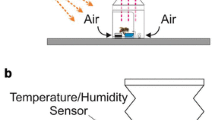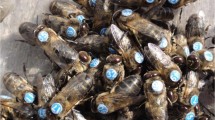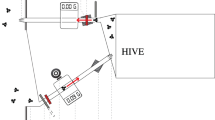Summary
Using manometric and gas analytical methods oxygen consumption\(\dot V_{O_2 }\), carbon dioxide production\(\dot V_{CO_2 }\), respiratory quotientRQ, (Fig. 1A-C) and thorax surface temperature difference ΔT ts (Fig. 3) were determined in single bees. The animals were either sitting in respiratory chambers or were suspended by the scutum, in which case they were resting, ‘walking’ (turning a small polystyrene ball) or flying in a closed miniature wind tunnel.
During resting (sitting in Warburg vessels) at an ambient temperatureT a=10°C,RQ was 1.01±0.2 (n=905) with variations due to method (Fig. 1D, E).RQ values during walking were determined in single cases. In no case were they significantly different from 1.00. After the first 10 min of flight meanRQ was 1.00±0.04. It was significantly smaller than 1.00 (RQ=0.97) only during the last 5% of long-time flights (mean flight duration 58.8±28.8 min). With the exception of near-exhaustion conditions no signs of fuels other than carbohydrates were found.
Metabolic rateP m was 19.71±21.38 mW g−1 during ‘resting’ at 20°C≤T a≤30°C indicating that many resting bees actively thermoregulate at higherT a. After excluding bees which were actively thermoregulating, by an approximationP m was 5.65±2.44 mW g−1 at 20°C≤T a≤30°C. ‘True resting metabolic rate’ for sitting bees atT a=10°C was 1.31±0.53 mW g−1 (Fig. 2A, B).
A significant negative correlation was found between relative (specific) oxygen consumption\(\dot V_{O_2 }\)rel and body massM b at 85 mg≤M b≤150 mg.
At 0°C≤T ts≤16.5°C a significant (α-0.01) positive correlation was found between\(\dot V_{O_2 }\) and ΔT ts in single resting bees:\(\dot V_{O_2 }\) ΔT Ts+0.099, or betweenP m and ΔT ts:P m=1.343 ΔT ts+0.581 (Fig. 3D)\(\dot V_{O_2 }\) in ml h−1,P m in mW,T in °C).
During walking (duration 13.15±5.71 min,n=13) at 12.5°C≤T a≤21°C a stable ΔT ts of 11.41±3.37°C, corresponding to 167 mW g−1, was reached for 80 to 90% of the walking time (Fig. 4B).
During wind tunnel flights of tethered animals the minimal metabolic power measured in exhaustion experiments was 240 mW g−1. Calculation of factors of increase inP m is of limited value in poikilotherms, in which true resting conditions are not exactly defined.
Similar content being viewed by others
References
Bailey E (1975) Biochemistry of insect flight. Part 2: Fuel supply. In: Candy DJ, Kilby BA (eds) Insect biochemistry and function. Chapman and Hall, London
Barker RJ, Lehner Y (1972) Free amino acids in thoraces of flown honey bees,Apis mellifera L. (Hymenoptera: Apidae). Comp Biochem Physiol 43B:163–169
Bartholomew GA, Casey TM (1978) Oxygen consumption of moths during rest, pre-flight warm up, and flight in relation to body size and wing morphology. J Exp Biol 76:11–25
Beenakers AMT (1969) Carbohydrate and fat as a fuel for insect flight. A comparative study. J Insect Physiol 15:353–361
Beutler R (1937) Über den Blutzucker der Bienen. Z Vergl Physiol 24:71–115
Brandes C (1984) Tanztempo, Zuckerverbrauch, Lauf-, Fluggeschwindigkeit und Flügelschlagfrequenz vonApis mellifica bei subletaler Parathionvergiftung. Zool Jb Physiol 88:345–359
Cahill K, Lustick S (1976) Oxygen consumption and thermoregulation inApis mellifera workers and drones. Comp Biochem Physiol 55A:355–357
Ellington CP (1984) The aerodynamics of hovering insect flight. Phil Trans Roy Soc London B 306:1–181
Esch H (1960) Über die Körpertemperaturen und den Wärmehaushalt vonApis mellifica. Z Vergl Physiol 43:305–335
Esch H (1976) Body temperature and flight performance of honey bees in a servomechanically controlled wind tunnel. J Comp Physiol 109:265–277
Farrar MD (1931) The metabolism of the adult honeybee. J Ecol Entomol 24:611
Feller P (1985) Windkanalflug von Honigbienen (Apis mellifica carnica): Untersuchungen zu Treibstoffverbrauch, Flugphysiologie und Thermoregulation. Diplomarbeit, Universität des Saarlandes, unpublished
Feller P, Nachtigall W (1989) Flight of the honey bee. II. Innerand surface thorax temperatures and energetic criteria, correlated to flight parameters. J Comp Physiol B 158:719–727
Free JB, Spencer-Booth Y (1958) Observations on the temperature regulation and food consumption of honeybees (Apis mellifera). J Exp Biol 35:930–937
Heinrich B (1975) Thermoregulation in bumblebees. II. Energetics of warm-up and free flight. J Comp Physiol 96:155–166
Heinrich B (1979) Keeping a cool head: honeybee thermoregulation. Science 205:1269–1271
Heinrich B (1981) The mechanisms and energetics of honeybee swarm temperature regulation. J Exp Biol 91:25–55
Heran H, Wanke L (1952) Beobachtungen über die Entfernungsmeldung der Sammelbienen. Z Vergl Physiol 34:383–393
Hereid CF II, Prawel DA, Full RJ (1981) Energetics of running cockroaches. Science 212:331–333
Hocking B (1953) The intrinsic range and speed of flight of insects. Trans R Entomol Soc Lond 104:223–345
Jensen TF, Holm-Jensen I (1980) Energetic cost of running in workers of three ant species.Formica fusca L.,Formica rufa andCamponotus herculeanus L. (Hymenoptera, Formicidae). J Comp Physiol 137:151–156
John M (1958) Über den Gesamtkohlenhydrat- und Glykogenhaushalt der Bienen (Apis mellifica). Z Vergl Physiol 41:204–220
Jongbloed J, Wiersma CAG (1934) Der Stoffwechsel der Honigbiene während des Fliegens. Z Vergl Physiol 21:519–533
Jungmann R (1984) Stoffwechselphysiologische Untersuchungen an in einem Miniaturwindkanal fliegenden Honigbienen (Apis mellifica). Diplomarbeit, Universität des Saarlandes, unpublished
Jungmann R, Rothe U, Nachtigall W (1989) Flight of the honey bee. I. Thorax surface temperature and thermoregulation during tethered flight. J Comp Physiol B 158:711–718
Kestler P (1978) Atembewegungen und Gasaustausch bei der Ruheatmung adulter terrestrischer Insekten. Verh Dtsch Zool Ges 1978:268
Kosmin NP, Alpatow WW, Resnitschenko MS (1932) Zur Kenntnis des Gaswechsels und des Energieverbrauchs bei der Biene in Beziehung zu deren Aktivität. Z Vergl Physiol 17:408–422
Lighton JRB (1988) Discontinuous CO2 emission in a small insect, the formicine antCamponotus vicinus. J Exp Biol 134:363–376
Lindauer M (1954) Temperaturregulation and Wasserhaushalt im Bienenstaat. Z Vergl Physiol 36:391–432
Ludwig HW (1962) Der Sauerstoffkonsum und RQ fliegender Insekten. Verh Deutsch Zoolog Ges Wien 1962:355–359
Miller PL (1966) The regulation of breathing in insects. Adv Insect Physiol 3:279–354
Nachtigall W, Rothe U, Feller P, Jungmann R (1989) Flight of the honey bee III. Flight metabolic power, calculated from gas analysis, thermoregulation and fuel consumption. J Comp Physiol B 158:729–737
Parhon M (1909) Les échanges nutritifs chez les abeilles pendant les quatres saisons. Ann Soc Nat Zool 9:1–50
Planke M, Lensing W (in press) Metabolic measurement of honey bee. J Apid Res
Rosow SA (1946) Food consumption by bees. Beekeeping 23:8
Rothe U (1983) Stoffwechselphysiologische Untersuchungen an ruhenden, laufenden und fliegenden Honigbienen (Apis mellifica carnica). Dissertation Universität des Saarlandes, unpublished
Rothe U, Nachtigall W (1980) Zur Haltung vonApis mellifica in einem Flugraum. Apidologie 11:17–24
Rothe U, Nachtigall W (1982) Erfahrungen mit einem Bienenflugraum. Spontane Königinnenaufzucht und Lebensdaueranalysen. Apidologie 13:241–246
Schreiner T (1952) Über den Nahrungstransport im Darm der Honigbiene. Z Vergl Physiol 34:278–298
Sotavalta O (1954) On the fuel consumption of the honeybee (Apis mellifica L.) in flight experiments. Ann Zool Soc “Vanamo” 16:1–27
Southwick EE (1982) Metabolic energy in intact honey bee colonies. Comp Biochem Physiol 71A:277–281
Steidle-Zander E (1921) Das Leben der Bienen. Stuttgart
Tauchert F (1930) Weitere Stoffwechseluntersuchungen an Insekten. Z Biol 89:541–546
Weis-Fogh T (1952) Fat combustion and metabolic rate in flying locusts. Phil Trans R Soc Lond 237:1–36
Weis-Fogh T (1972) Energetics of hovering flight in hummingbirds and in Drosophila. J Exp Biol 56:79–104
Withers PC (1981) The effect of ambient air pressure on oxygen consumption of resting and hovering honeybees. J Comp Physiol 141:433–437
Wohlgemuth R (1957) Die Temperaturregulation des Bienenvolkes unter regeltheoretischen Gesichtspunkten. Z Vergl Physiol 40:119–161
Woodworth CE (1932) Some effects of reduced atmospheric pressure at honeybee respiration. J Ecol Entomol 25:1036
Zebe E (1954) Über den Stoffwechsel der Lepidopteren. Z Vergl Physiol 36:290–317
Author information
Authors and Affiliations
Rights and permissions
About this article
Cite this article
Rothe, U., Nachtigall, W. Flight of the honey bee. J Comp Physiol B 158, 739–749 (1989). https://doi.org/10.1007/BF00693012
Accepted:
Issue Date:
DOI: https://doi.org/10.1007/BF00693012




